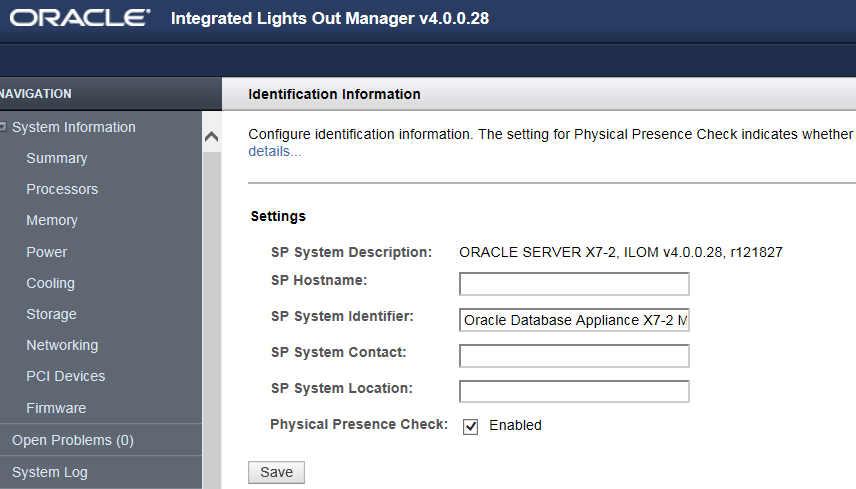A long time ago, ODA referred to the only model that existed (nearly). Actually, not so long time ago, as ODA X3, X4 and X5 were released between 2013 and 2015. And it was quite the same hardware.
Now there is 3 current models in the X7 range, and they were 4 in the previous generation (X6).
ODA is now divided in 2 main lines. High Availability models, understand 2 nodes and a shared storage like the first generations. And lite models, with only 1 node and local NVMe SSD, obviously more afordable than HA models.
Beginning with X6, lite models came with a brand new ISO for reimaging, including the new odacli, a higher level administration tool (compared to oakcli), and X6-2HA remained with the same ISO as previous gen models.
But now, X7 range saw the adoption of odacli for all models. And if you stick with bare metal, ISO is now the same for reimaging all the range. Quite convenient isn’t it?
I recently asked myself: how the reimaging process determines the correct model?
First of all, you can look at your ODA model with odaadmcli:
odaadmcli show env_hw BM ODA X7-2 Medium
As you may know, reimaging process is fully automatic, and you have nothing to provide unless the correct ISO.
If ODA X7-S has only one Xeon CPU, nodes for ODA X7-M and X7-2HA are barelly the same, so what differs from them?
I first thought it was somewhere hardcoded, but it doesn’t seems to. ODA X7 is just the same hardware as the multi-purpose Oracle Server X7-2. Among the ISO files, I found a script that detects correct model by counting the number of local NVMe SSD (quite smart because HA model has only M2 SSD disks for the system and no NVMe SSDs), but it was not used during the reimaging…
Looking deeper on the system side, I found that model was simply part of the grub.conf boot options:
kernel /vmlinuz-4.1.12-94.4.1.el6uek.x86_64 ro root=/dev/mapper/VolGroupSys-LogVolRoot rd_NO_LUKS rd_MD_UUID=1ee3fdbc:3fdcdcf4:3a28f182:1a674b68 rd_LVM_LV=VolGroupSys/LogVolRoot rd_LVM_LV=VolGroupSys/LogVolSwap SYSFONT=latarcyrheb-sun16 pci=noaer crashkernel=256M@64M loglevel=3 panic=60 transparent_hugepage=never biosdevname=1 ipv6.disable=1 debug audit=1 intel_idle.max_cstate=1 nofloppy nomce numa=off console=ttyS0,115200n8 console=tty0 KEYBOARDTYPE=pc KEYTABLE=us rd_NO_DM LANG=en_US.UTF-8 PRODUCT=ORACLE_SERVER_X7-2 TYPE=X7_2_LITE_M
I discovered that odacli is based on this information. If you remove these settings, your ODA will be considered as a HA model, and odacli will crash:
DCS-10002: Invalid hardware platform
Okay, but it doesn’t tell me how the reimaging process decides which model to put in the grub.conf parameters…
Actually, grub.conf is configured at deployment with something from the ILOM, the “SP System identifier” located in the settings under the ILOM hostname:
As you can see, this field can be edited, and you can put everything in it (didn’t tried EXADATA…). Unfortunatly, it’s just below the “SP Hostname” and some people would probably like to change this identifier in the same time they are feeding the hostname. But it’s a bad idea because your ODA would not be correctly deployed for the next time you’ll need to reimage!
Be aware of that and please do not touch this identifier. Keep it as it is.
Notes :
– reimaging was done with patch 23530609 (version 12.2.1.2.0)
– default hostname for the ODA ILOM is… the SP System Identifier

![Thumbnail [60x60]](https://www.dbi-services.com/blog/wp-content/uploads/2022/08/JDU_web-min-scaled.jpg)
![Thumbnail [90x90]](https://www.dbi-services.com/blog/wp-content/uploads/2022/10/STS_web-min-scaled.jpg)
![Thumbnail [90x90]](https://www.dbi-services.com/blog/wp-content/uploads/2022/08/STH_web-min-scaled.jpg)
![Thumbnail [90x90]](https://www.dbi-services.com/blog/wp-content/uploads/2022/09/SNA_web-min-scaled.jpg)